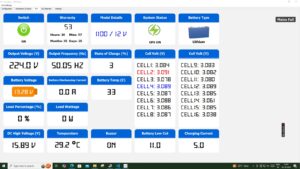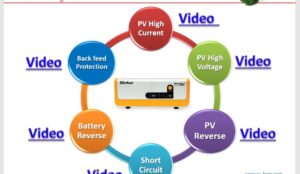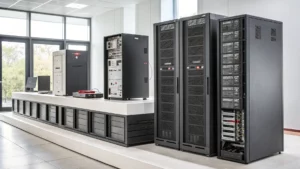The Lifespan of Lithium vs. Lead Acid: A Comparative Study
The Lifespan of Lithium vs. Lead Acid Battery: A Comparative Study, This study compares the lifespan of lithium and lead-acid batteries, two common battery technologies used in various applications, including inverters, solar power systems, and electronic devices.
The Lifespan of Lithium vs. Lead Acid: A Comparative Study
Lithium Inverter: A lithium inverter can last for over 10 years, but its functionality is dependent on the battery it’s connected to and the conditions it’s exposed to.
Lithium inverters have several advantages over those that use traditional sealed lead-acid (SLA) batteries. Here’s a breakdown of the key benefits: Lifespan Definition Battery lifespan refers to the total duration a battery can deliver its intended performance before needing replacement. It’s typically measured in years or the number of charge-discharge cycles the battery can withstand before falling below a specific capacity threshold (often 80% of its original capacity).Lithium vs. Lead Acid Battery Lifespan
Lifespan Definition Battery lifespan refers to the total duration a battery can deliver its intended performance before needing replacement. It’s typically measured in years or the number of charge-discharge cycles the battery can withstand before falling below a specific capacity threshold (often 80% of its original capacity).Lithium vs. Lead Acid Battery Lifespan
Lithium Batteries:
Lifespan: 7-10 years or 3000-5000 cycles (depending on factors like depth of discharge)The Lifespan of Lithium vs. Lead Acid: A Comparative Study
Advantages:
- Longer lifespan compared to lead-acid batteries, leading to fewer replacements and lower overall costs in the long run.
- Less capacity degradation with each cycle, allowing for more consistent performance throughout its lifespan.
- Deeper discharge tolerance (around 80%) without significant lifespan reduction, providing more usable backup power.
The Lifespan of Lithium vs. Lead Acid: A Comparative Study
- Depth of discharge: Lithium batteries can be discharged much deeper (around 80%) without harming their capacity. In contrast, discharging SLA batteries beyond 50% can shorten their lifespan. This allows lithium inverters to provide more backup power during outages.
- Faster charging: Lithium batteries recharge much faster than SLA batteries, minimizing downtime after a power cut. This is crucial for situations where you rely heavily on backup power.
- Lower maintenance: Unlike SLA batteries, lithium batteries require minimal maintenance. You won’t need to worry about topping up water or checking acid levels.
 The Lifespan of Lithium vs. Lead Acid: A Comparative Study
The Lifespan of Lithium vs. Lead Acid: A Comparative Study
Tubular Lead Acid Battery: Tubular lead acid batteries, while a popular choice for inverter systems, come with some drawbacks compared to newer lithium battery technology, These batteries typically have a lifespan of 2-3 years. Their capacity degrades with each charge/discharge cycle, and deep discharges significantly shorten their life.
- Lifespan: 2-3 years or 300-500 cycles (depending on factors like depth of discharge)
- Disadvantages:
- Shorter lifespan compared to lithium batteries, requiring more frequent replacements and higher overall costs.
- Higher capacity degradation with each cycle leads to a faster decline in performance.
- Limited depth of discharge (around 50%) to maintain lifespan, reducing usable backup power.

Limited Depth of Discharge: Deep discharging (below 50%) can significantly shorten a tubular battery’s lifespan. This limits the usable capacity of the battery during an outage.
Slower charging: Tubular batteries take longer to recharge than lithium batteries, increasing downtime after a power cut.
Maintenance requirements: Unlike lithium batteries, tubular batteries require regular maintenance, such as topping up with distilled water and cleaning the terminals. Neglecting this maintenance can lead to reduced performance and a shorter lifespan.
Weight and size: Tubular batteries are much heavier and bulkier than lithium batteries for the same energy storage capacity. This can be a disadvantage for space-constrained applications.
Environmental impact: Lead is a toxic material, and improper disposal of tubular batteries can pose environmental hazards. Additionally, they vent hydrogen gas during operation, which requires proper ventilation.
Temperature: Extreme temperatures (hot or cold) can accelerate capacity degradation and reduce lifespan for both battery types.
Charging habits: Using fast charging constantly or keeping the battery at very high or low charge levels can reduce lifespan for both types.
The Lifespan of Lithium vs. Lead Acid: A Comparative Study
| ComponentLifespanLithium Inverter10+ yearsTubular Lead-Acid Battery2-3 yearsLithium Battery (used with Lithium Inverter)7-10 years |
The Lifespan of Lithium vs. Lead Acid: A Comparative Study
Overall:
A lithium inverter paired with a lithium battery will provide significantly longer backup power and overall system life compared to a setup using a tubular lead acid battery.
Here are some additional points to consider:
Lithium Battery Cycles:
Lithium battery cycles refer to the complete process of discharging a lithium battery, and then recharging it back to full capacity. This cycle repeats throughout the battery’s lifespan, but with each cycle, the battery’s capacity to hold a charge gradually decreases. Here’s a breakdown of key points about lithium battery cycles:
Impact on lifespan: The number of cycles a lithium battery can endure significantly impacts its lifespan. Most lithium batteries used in inverters and electronic devices are rated for 300 to 500 cycles before dropping below 80% of their original capacity.
Depth of discharge: The depth of discharge (DOD) refers to how much of a battery’s capacity is used before recharging. Shorter discharge cycles (using less of the capacity) contribute to a longer lifespan. For example, discharging a battery to 50% and then recharging it counts as half a cycle.
Factors affecting cycles: Several factors can influence the number of cycles a lithium battery experiences:
- Depth of discharge: As mentioned earlier, shallower discharges contribute to more cycles.
- Temperature: Extreme temperatures, both hot and cold, can accelerate capacity degradation and reduce cycle life.
- Charging habits: Constantly using fast charging or keeping the battery at very high or low charge levels can also reduce cycles.
The Lifespan of Lithium vs. Lead Acid: A Comparative Study Here are some things to consider to maximize the number of cycles in your lithium battery:
Avoid full discharges: Try not to completely drain your battery before recharging. Ideally, stay between 20% and 80% charge level for most cycles.
Use proper chargers: Always use the charger recommended by the manufacturer to avoid damaging the battery.
Maintain moderate temperatures: Avoid exposing your battery to extreme heat or cold.
Shallow discharges preferred: Whenever possible, perform shorter discharge cycles and recharge more frequently.
By following these practices, you can optimize the number of cycles your lithium battery goes through and extend its overall lifespan.
Depth of Discharge: Lithium batteries can be discharged deeper (around 80%) without harming their capacity, unlike tubular batteries which are limited to around 50% depth of discharge.
Maintenance: Lithium batteries require minimal maintenance, while tubular batteries need regular topping up of distilled water.
Key Takeaways lithium batteries offer a significantly longer lifespan compared to lead-acid batteries, making them a more cost-effective choice in the long run. Lithium batteries can be discharged deeper without impacting their lifespan as much as lead-acid batteries, providing more usable backup power. Both lithium and lead-acid batteries benefit from practices that minimize the depth of discharge, avoid extreme temperatures, and use proper charging methods.
The Lifespan of Lithium vs. Lead Acid: A Comparative StudyIn conclusion, while the inverter itself might have a similar lifespan regardless of the battery type, the choice of battery significantly impacts the overall system’s life expectancy and performance. Lithium batteries offer a clear advantage in terms of lifespan and reliability.https://suvastika.com/lithium-inbuilt-battery-ess-2500/




